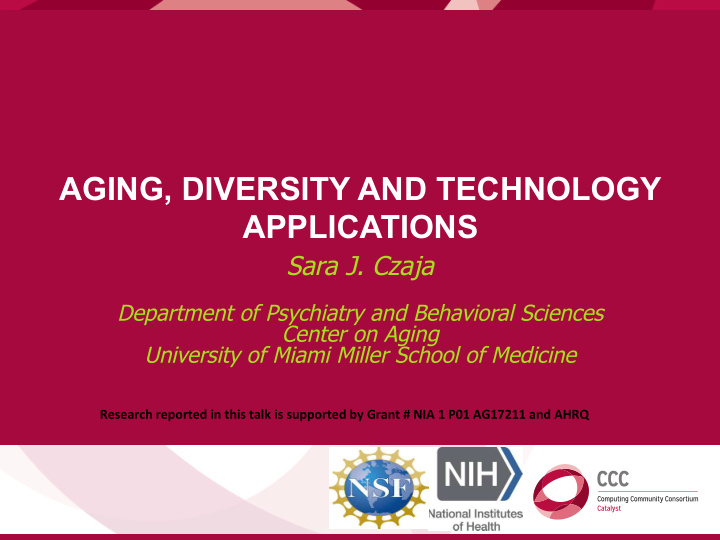



AGING, DIVERSITY AND TECHNOLOGY APPLICATIONS Sara J. Czaja Department of Psychiatry and Behavioral Sciences Center on Aging University of Miami Miller School of Medicine Research ¡reported ¡in ¡this ¡talk ¡is ¡supported ¡by ¡Grant ¡# ¡NIA ¡1 ¡P01 ¡AG17211 ¡and ¡AHRQ ¡
OVERVIEW • Pose some issues and challenges for the design and research community. • Present some data on the increasing diversity of the older adult population and examples of the implications for technology systems and applications. • Discuss the role of technology for family caregivers.
ISSUES/CHALLENGES FOR THE RESEARCH AND DESIGN COMMUNITY • Given the changing face of aging what strategies can we use to minimize digital disparities and ensure that vulnerable older adult populations have “meaningful access” to technology applications that meet their needs and enhance their quality of life? • How do we design/implement technology so that technology applications help maintain functioning and independence without negatively impacting on the performance potential and social relationships/ interactions of individuals? • What types of technology applications best support family caregivers and in what capacity? • What types of research strategies are optimal for evaluating the efficacy and effectiveness of technology solutions?
WHO ARE OLDER ADULTS? • Current and future populations of older adults are and will be characterized by increased diversity: – Age (2012) • 65 -74: 24 million people • 75-84: 13.3 million people • 85+: 5.9 million people • 100+: 61, 985 people ( é 93% since 1980) – Ethnicity/Culture • Racial/Ethnic Minorities – 2012: 21% of the 65+ population – 2030: 28% of the 65+ population » Hispanics é 155% » African Americans é 104% » Asian é 119% » American Indian and Native Alaskans é 116% – Living Arrangements – Live with spouse: 57% – Live alone: 28% – Institutional Settings: 3.5% – Senior Housing: 2.7% – Rural areas: 21.6%
WHO ARE OLDER ADULTS? – Education • High School Education: 83% • College Degree or Higher: 25% – Income • Less than $15,000: 34% • $15,000 – $35,000: 38% • Greater than $35,000: 28% – Literacy • Below Basic Prose Literacy: 26% • Below Basic Health Literacy: 29% • Basic Health Literacy: 30% Intermediate Health Literacy: 38% • – Health Status • Visual impairments: ~ 16% • Hearing impairments: ~ 26% • One Chronic condition: 80% • At least two chronic conditions: 50% • ADL Limitations: 28% • IADL Limitations: 12% • Mental Health Concerns: 20% – Cognitive Impairments • Normative age-related decline in fluid abilities • Report memory loss: ~ 13% • MCI: ~10-20% • Alzheimer’s Disease: 11%
IMPLICATIONS FOR TECHNOLOGY APPLICATIONS • User Needs and Preferences – What types of technologies best: • Compensate for age-related declines or disabilities – Assistive technologies • Prevent further declines of disabilities – Monitoring systems; disease management systems • Improve well-being – Social networking; educational applications; support ADL/IADL tasks • Interface Design – Cultural/language issues • Translation; cultural differences in communication, health beliefs – Complexity • Literacy demands • Cognitive demands – learnability, memorability, cost of adoption – Accessibility • Changes in sensory-motor functions • Disabilities
Flesch-‑Kincaid ¡grade ¡level ¡= ¡11.5 ¡
Flesch- Kincaid Grade Level: 11.2
IMPLICATIONS FOR TECHNOLOGY APPLICATIONS • Taha, Czaja, Sharit & Morrow (2013): – Evaluated the ability of a sample of lower SES middle-aged and older adults to use a simulated version of the Epic patient portal to perform routine health management tasks: • A significant percentage of the sample had difficulty performing the tasks • Cognitive abilities (e.g., reasoning, memory) and numeracy skills were significant predictors of performance • There were significant discrepancies between self-ratings and objective ratings of numeracy • Czaja, Zarcadoolas, Vaughan et al (in Press) – Evaluated the ability of a lower SES sample of adult patients to use the three currently available PHRs.: • The majority of participants: – had difficulty performing the tasks – reported usability problems (e.g., complex language) – perceived PHRs as potentially valuable
IMPLICATIONS FOR TECHNOLOGY APPLICATIONS • Training, Instructional Support and Technical Support – How to best train – Design of instructional materials – What if the system breaks down? • Security and Privacy Issues • Cost and Payment • Access – Awareness – Perceived utility and value – Acceptance – Usability – Keeping abreast with changes in system design
USA INTERNET USE BY AGE 2000-2013 Figure ¡1. ¡ ¡Percent ¡US ¡Internet ¡use ¡by ¡age ¡group. ¡ ¡Data ¡selected ¡at ¡near ¡annual ¡intervals ¡from ¡the ¡Pew ¡Internet ¡& ¡American ¡Life ¡spreadsheet ¡ hBp://www.pewinternet.org/StaEc-‑Pages/Trend-‑Data-‑%28Adults%29/Usage-‑Over-‑Time.aspx ¡supplemented ¡by ¡ hBp://www.pewinternet.org/Trend-‑Data-‑%28Adults%29/Whos-‑Online.aspx, ¡accessed ¡12/30/2013. ¡
INTERNET, BROADBAND, AND TABLET ADOPTION AMONG SENIORS
CELL PHONE AND SMARTPHONE ADOPTION AMONG SENIORS
TABLET OWNERSHIP 2013 hBp://pewinternet.org/~/media//Files/Reports/2013/PIP_Tablet%20ownership%202013.pdf ¡
SMARTPHONE BY AGE, INCOME US ¡Smartphone ¡ownership ¡in ¡2013 ¡by ¡age ¡and ¡income, ¡with ¡income ¡groups ¡shown ¡in ¡dollar ¡ranges ¡of ¡<30,000, ¡30-‑75,000, ¡75,000+. ¡ ¡Data ¡from ¡Smith ¡(2013). ¡
FAMILY CAREGIVERS • Technology can aid Family Caregivers – Delivery of intervention programs and services – Communication • Other family members • Other caregivers • Healthcare Professionals – Access to Information – Monitoring of Patient – Assessment of patient and caregiver – Respite • Issues – What technology applications best meet caregiver needs – Cost-effectiveness – Integration with other aspects of healthcare systems and day-to-day lives – Need for more rigorous research and evaluation
Recommend
More recommend